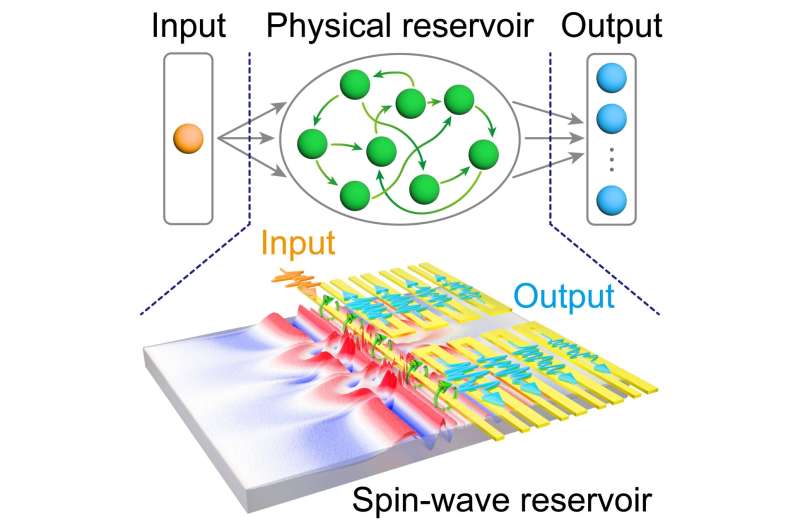
October 15, 2024 by Yokohama National University
Collected at: https://phys.org/news/2024-10-reservoir-chips-edge.html
Reservoir computing (RC) has a few benefits over other artificial neural networks, including the reservoir that gives this technique its name. The reservoir functions mainly to nonlinearly transform input data more quickly and efficiently. Spin waves, propagating wave-like disturbances arising from magnetic interactions, can traverse through a material. These excitations are driven by the spin of electrons.
By exploiting the coupling between electrical and spin degrees of freedom, spin-wave reservoir chips offer a novel platform for electrical-to-spin conversion. These devices incorporate a physical reservoir functioning as a nonlinear analog element, capable of transforming electrical signals into a corresponding spin-wave representation, improving learning accuracy, and short-term memory tasks. Practical application of this technology can make huge differences in fields from biomedical imaging to autonomous vehicle technology.
In a study published in Physical Review Applied, the device of interest has been designed to facilitate the detection of signals from three spherical wave-excited surface mode spin waves. The spin wave reservoir device developed by researchers provided results indicating that the electrical signal of surface mode spin waves was detectable at all four of the observation antennas, proving its function as a one-input four-output reservoir.
Before this, most studies on the spin-wave reservoir were mostly theoretical. However, the results of the study confirm the effectiveness of this method without having to use a virtual node (a method of data distribution and task simplification) to evaluate external magnetic fields, furthering spin-wave reservoir chips as a practical method, not just a theoretical one.
Information gleaned from this study was obtained through the use of an easily magnetized metal alloy thin film having the properties of a magnet, meaning it can be magnetized and will stay magnetized for a long time. The spin-waves are excited using magnetic fields and the waveforms are detected using antennas, with the external fields estimated via spin-wave reservoir.
The detection antennas confirm learning accuracy improvements, as well as confirming an increase in short-term memory. “The results demonstrate the device’s capacity to retain memory up to one step prior in short-term memory tasks, while confirming the effectiveness of spin-wave interference induced by Huygens slits in enhancing nonlinearity,” said Koji Sekiguchi, author and researcher of this study.
This is detected from the time differences in the signals detected by each antenna. Huygens slits are small openings that allow light diffraction, which then follows the Huygens principle such that each point on a light wave can act as a point where a circular wave spreads out from the slit. This principle induces spin-wave interference, which is the driving action for this type of technology.
As this is the first prototype that can be implemented in a device, it is not without a need for improvement. The performance can be limited under low levels of excitation, which can make it difficult for this method to be used for highly nonlinear information transformation. However, in both short-term memory tasks and error-correcting tasks, the spin-wave reservoir chip outperforms other physical reservoirs.
“Our ultimate goal is to establish edge computing technology utilizing spin-wave reservoir chips, with the aim of developing a wide range of applications including biomedical imaging and autonomous vehicles,” said Sekiguchi.
With this, researchers believe practical implementation is near.
Sho Nagase and Shoki Nezu of the Graduate School of Engineering Science at Yokohama National University and Koji Sekiguchi of the Institute of Advanced Science, the Institute of Multidisciplinary Sciences and the Faculty of Engineering at Yokohama National University contributed to this research.
More information: Sho Nagase et al, Spin-wave reservoir chips with short-term memory for high-speed estimation of external magnetic fields, Physical Review Applied (2024). DOI: 10.1103/PhysRevApplied.22.024072
Journal information: Physical Review Applied

Leave a Reply